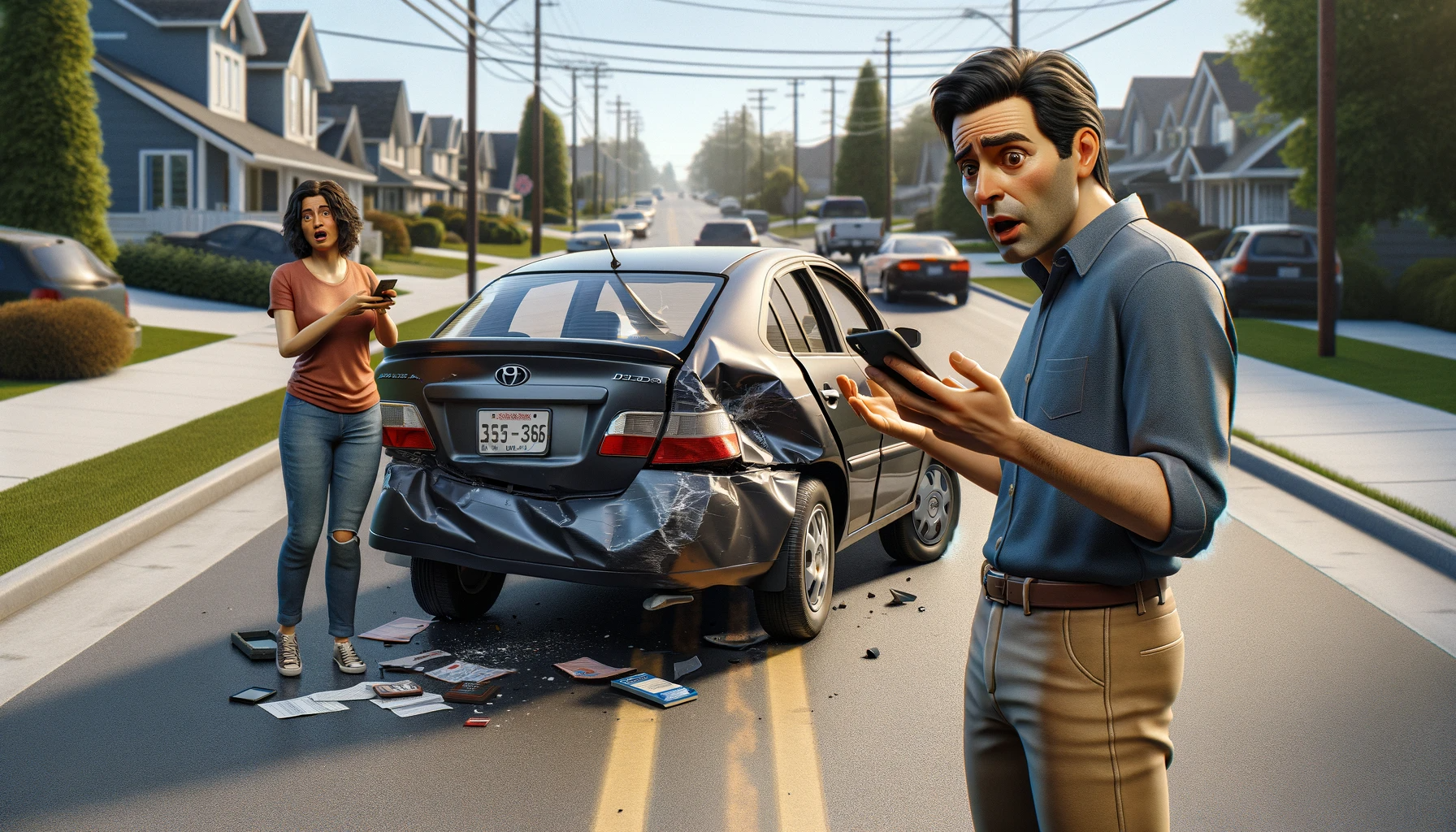Understanding Rear-End Collisions
The Nature of Rear-End Collisions
Rear-end collisions are a common type of road
Accident that occur when the front of one vehicle hits the back of another. This often happens when the car in front abruptly stops and the following car does not have enough time or distance to stop and avoid the collision. Despite often being less severe than other types of accidents, rear-end collisions can still cause significant damage to vehicles and injuries to passengers.
Causes of Rear-End Collisions
There are numerous causes of rear-end collisions, with most of them related to driver behavior. Distracted driving such as using phones, eating, or adjusting the radio, aggressive driving, tailgating, and speeding are major contributors. Weather conditions like rain, snow, or fog can also increase the risk of rear-end collisions owing to reduced visibility and slippery roads.
The Impact and Injuries from Rear-End Collisions
Despite appearing less dramatic than other
Accident types, rear-end collisions can result in serious injuries, especially at high speeds. The sudden impact can cause whiplash, a painful neck
Injury resulting from the rapid forward-and-backward movement of the head. Other common injuries include spinal cord injuries, bruises, fractures, concussions, and even traumatic
Brain injury depending on the severity of the crash.
The Role of Negligence in Rear-End Collisions
In many regions, the driver of the car who hits the other from behind is typically considered at fault for a rear-end collision. The logic behind this is based on the assumption that the following driver should maintain a safe distance and be prepared for any sudden stops. However, there can be exceptions to this rule, and every case is examined individually taking into account all the circumstances surrounding the accident.
The Legal Implications of Rear-End Collisions
Depending on the region, the fines for rear-end collisions can vary. Factors influencing the fine might include the severity of damage, any injuries caused, and whether the offending driver was under the influence of alcohol or drugs. In some cases, if negligence or intentional misconduct can be proven, the driver may also face criminal charges in addition to civil penalties.
Determining Liability in a Rear-End Collision
Understanding Fault in Rear-End Collisions
In most scenarios, the driver of the vehicle that rear-ends another car is usually considered at fault due to a common rule known as the "rear-end rule". This rule states that a motorist driving behind another vehicle has a duty to follow at a safe distance that allows ample time and space to respond if the car in front unexpectedly stops or slows down.

The Role of Negligence
To determine liability in a rear-end collision, negligence plays a significant role. The basic principle of negligence suggests that drivers must exercise reasonable care to avoid causing harm to others on the road. If a driver fails to exercise this care and causes an
Accident, they can be held liable for the damages. For instance, if a driver is distracted, speeding, tailgating or not following traffic rules, they are likely to be considered negligent.
Nuances to the 'Rear-End Rule'
There can be exceptions to the general 'rear-end rule', where the driver of the car in front could share some liability for the accident. Situations like abrupt lane changes, brake failures (if maintenance negligence is proven) or if the front car's brake lights aren't working, the responsibility might partially or entirely shift to them.
Comparative and Contributory Negligence
The determination of liability can also depend on whether your state follows comparative or contributory negligence laws. In states that follow comparative negligence, even if the victim was partially at fault, they could still recover damages, but it would be reduced by their percentage of fault. On the other hand, states following contributory negligence laws prohibit victims from recovering any damages if they are found to be even 1% at fault.
Evidence Gathering
The importance of gathering evidence after a rear-end collision cannot be overemphasized. Evidence forms the basis for proving liability during legal proceedings. This might include witness statements, traffic camera footage, police reports or physical evidence from the
Accident scene such as skid marks and car damages. Remember to document as much as possible, it could significantly impact the outcome of the claim.
Factors Influencing the Fine for Rear-End Collisions
Consideration of Fault
The court will initially assess who was at fault in the incident. It is typically presumed that the driver who hit the rear end is to blame in most cases. However, if there's evidence to indicate that the leading driver played a part in causing the collision, it could influence the fine imposed. For instance, if the leading driver abruptly stopped without warning or if their vehicle’s brake lights were not functioning, these factors might lessen the fine for the driver who hit from behind.
Another influencing factor is the severity of the accident. Rear-end collisions can range from minor fender-benders to major crashes leading to significant damage and
Injury. If the collision resulted in massive property damage, serious injuries, or even fatalities, the party at fault could face higher fines. Conversely, less severe accidents generally result in lower fines.
Driver’s History
An offender's driving history can significantly influence the fine for a rear-end collision. If the driver responsible for the collision has a clean record, they may receive a more lenient penalty. On the other hand, repeat offenders or those with previous traffic violations, especially related to similar incidents, may face stiffer fines due to their history of non-compliance with traffic rules.
Vehicular Law Compliance
Compliance with vehicular laws at the time of the
Accident also comes into play when determining the fine. If the at-fault driver was found to be under the influence, speeding, using a cellphone while driving, or neglecting any other traffic laws at the time of the accident, this could lead to a higher fine.
Plea and Legal Representation
Finally, the fine can depend on whether the accused pleads guilty or not guilty. A guilty plea can sometimes, but not always, lead to reduced fines, whereas contesting the charge might result in higher court costs. Additionally, the quality and efficiency of legal representation can significantly influence the outcome of the case and the resultant fine.
Average Fine for a Rear-End Collision
The fine for a rear-end collision can vary widely based on the specific circumstances of the incident, local traffic laws, and whether or not any injuries were caused.
Typical Fines
On average, the fine for a straightforward rear-end collision, where no one is injured and both cars can drive away from the scene, tends to range from $100 to $200. This is usually seen as a "standard" fine for a minor traffic violation, and is often enforced when one driver has failed to keep a safe following distance.
Increased Costs with Aggravating Factors
However, the fine can significantly increase with the presence of aggravating factors. These can include cases where the collision led to
Bodily injury or substantial property damage, instances where the offending driver was under the influence of alcohol or drugs, or situations where the collision led to a road traffic offense like fleeing the scene or reckless driving. In such cases, fines can range from $500 up to several thousands of dollars.
Fines Depending on Jurisdiction
Fines also tend to vary depending on the jurisdiction in which the collision occurred. Some cities, states, or countries impose harder penalties for rear-end collisions than others. Therefore, it is important to consider the location of the incident when evaluating potential fines.
Impact on Insurance Premiums
In addition to the actual fine imposed by law enforcement or the court, those found at fault for a rear-end collision may also face increased auto insurance premiums. While this is not a government-imposed fine, it is an additional cost that results from the
Accident.
Fines Paired with Other Penalties
Finally, fines for rear-end collisions are often paired with other penalties, such as points on your driving record, mandatory driving school, or, in serious cases, suspension or revocation of your driving license. In many jurisdictions, these penalties can be more impactful than the fine itself.
How State Laws Impact Rear-End Collision Fines
Degree of Fault
All states have laws that address rear-end collisions, but the way they are applied can vary significantly from state to state. Some states use a fault-based system, where the driver determined to be at fault for the collision is responsible for the fines and other costs associated with the accident. If the driver who hit the car from behind is found to be at fault, they may receive a fine or even risk losing their license.
Impact of No-Fault Laws
Other states follow a no-fault system, under which each driver’s insurance pays for their own damages, regardless of who caused the
Accident. In these states, a rear-end collision may result in insurance rate increases rather than fines, although serious violations like reckless driving may still result in fines.
Variation in Fines
In terms of actual fines for a rear-end collision, they can also vary widely from state to state. For instance, in California, the base fine for a rear-end collision could range from $20 to $70, while in Texas, it could run as high as $200. The variability depends on factors such as the severity of the collision, whether it resulted in
Injury or death, prior driving record, and even whether the driver was cooperative at the scene.
Consideration of Aggravating Factors
Several states also consider aggravating factors when determining fines for a rear-end collision. These could include excessive speed, tailgating, driving under the influence (DUI), or distracted driving. In certain cases, the base fine may be multiplied by the number of aggravating factors present. This could result in significantly higher fines and penalties.
Role of Traffic Violations
Finally, in some states, traffic violations related to the
Accident may also impact the fine levied. For example, if a driver was speeding or failed to maintain safe following distance and this led to the rear-end collision, the fine levied could be more than if no traffic violations were involved.
Effect of a Rear-End Collision on Driving Record
Impacts on Car Insurance Rates
A rear-end collision can significantly affect your car insurance rates. When you're at fault in a rear-end accident, your insurance provider may increase your premiums. This is because the insurer considers you as a risky driver due to your record of being involved in an accident. The amount of the increase varies depending on the severity of the accident, your past driving record, and the policies of your insurance company.

Influence on Driver's License Points
In many states, being at fault in a rear-end collision can add points to your driver’s license. Each state has a unique point system for traffic violations and accidents. From minor violations such as speeding tickets to more serious ones like causing an accident, each adds points to your license. Having too many points can lead to penalties, including suspension or revocation of your driving privileges.
Reporting Accidents to the Department of Motor Vehicles
Some states require drivers to report any accident to the Department of Motor Vehicles (DMV), especially if it involves
Injury, death, or significant property damage. Failure to report such incidents can result in further penalties. In some instances, the DMV may carry out its investigation, which can affect your driving record.
Long-Term Consequences on Driving Record
Rear-end collisions can stay on your driving record for years, typically 3 to 5 years for minor incidents and up to 10 years for serious accidents. This long-term presence can influence future insurance premiums, the ability to rent a vehicle, employment opportunities (especially jobs that demand a clean driving record), and potentially the renewal of your driver's license.
The Role of Defensive Driving Courses
After a rear-end collision, you may consider taking a defensive driving course. Several states allow these courses to remove points from your driving record or to prevent points from being added after an
Accident. Completion of these courses can help maintain lower insurance rates and a clean driving record. Always check with your state’s DMV or your insurance provider about eligibility and the potential benefits.
Preventing Rear-End Collisions and Avoiding Fines
Understanding the Causes
Rear-end collisions often occur due to distraction, tailgating, or failure to adapt to road conditions. Enhanced awareness about these triggers will help you adopt safer driving techniques. Always focus on the road and avoid using mobile phones or any gadgets while driving.
Maintaining Safe Distance
Following traffic too closely, also known as tailgating, is a leading cause of rear-end collisions. The 'Three Second Rule' is a simple way to ensure a safe following distance. Choose an object that the car in front of you passes, like a sign or a building, and start counting. If you pass the same object before you count to three seconds, you're following too closely and should slow down.
Fostering Defensive Driving Skills
Defensive driving courses can significantly improve your ability to prevent
Accidents and fines. They teach critical skills like hazard identification, risk understanding, and decision-making processes under pressure. In many jurisdictions, successful completion of a defensive driving course can even lead to reduced insurance premiums.
Adapting to Road and Weather Conditions
Poor weather conditions or bad road surfaces can increase the likelihood of rear-end collisions. In such scenarios, drivers should reduce their speed and increase the following distance even more than usual. Extra caution should be exercised during rain, snow, fog, or when driving on gravel or damaged roads.
Vehicle Maintenance
Regular vehicle maintenance also plays an integral role in preventing rear-end collisions. Ensuring your vehicle's brakes, tires, lights, and other safety equipment are functioning correctly can help avoid accidents. Regular checks and prompt repairs can contribute significantly towards collision prevention.
Conclusion
In conclusion, the fine for a rear-end collision can vary depending on several factors such as the severity of the
Accident, local traffic laws, and whether there were any injuries or property damage involved. It's essential to abide by traffic regulations and maintain a safe following distance to prevent rear-end collisions. However, if you find yourself in such a situation, it's crucial to seek legal advice and understand your rights and responsibilities.
Look for an attorney who has the right legal resources for your legal needs.
Contact us here on the
Warmuth Law website or through our hotline 888-517-9888.
Frequently Asked Questions (FAQ's)
1. What factors determine the fine for a rear-end collision?
The fine for a rear-end collision can be influenced by factors such as the extent of damage, whether there were injuries, if there was any recklessness or negligence involved, and local traffic laws.
2. Is there a standard fine amount for rear-end collisions?
There isn't a fixed standard fine for rear-end collisions, as it varies depending on jurisdiction and the circumstances of the
Accident. Fines may range from a few hundred to several thousand dollars.
3. Will my insurance cover the fine for a rear-end collision?
Insurance coverage for fines resulting from a rear-end collision depends on your policy and the specific circumstances of the
Accident. In many cases, insurance may cover some or all of the costs associated with the collision, but it's essential to review your policy and consult with your insurance provider.
4. What are the potential consequences of a rear-end collision besides fines?
In addition to fines, consequences of a rear-end collision may include points on your driving record, increased insurance premiums, civil lawsuits for damages or injuries, and even criminal charges in severe cases of reckless driving or DUI.
5. Can I dispute a fine for a rear-end collision?
Yes, you can dispute a fine for a rear-end collision if you believe it was issued unfairly or inaccurately. To dispute a fine, you typically need to follow the procedures outlined by the issuing authority, provide evidence to support your case, and may need to attend a hearing or court appearance.













